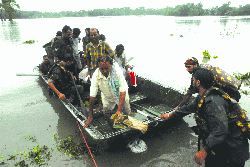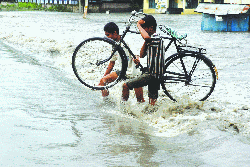Archives
FLOODS IN ASSAM LEAVE A TRAIL OD DEVASTATION

This time, apart from the Brahmaputra, its tributaries like Bordikorai, Dikhow, Dichangparia, Buridihing Jiabharali, Pagladia, Manas, Beki, Ai, Champabati, Gourang, Tipkai and Gangadhar all were at spate and caused much damage to crops and property.
During the last three waves of flood, more than 540 wooden and RCC bridges, nearly 754 kms of village, PWD and National Highway was washed away while property and crops worth several crores damaged.
Lakhs of people who were displaced and took shelter in camps and returned to their villages after the receding of flood waters are struggling to manage even a day’s meal.
The worst affected in this flood, however is Majuli sub-division of Jorhat district as apart from a few areas with high lands, the entire sub-division was inundated and people had to deal with the flood water for days together.
Similarly, the breaching of embankments in Puthimari in Kamrup district and release of water by the Arunachal government and Bhutan caused much damage in Dhemaji, Lakhimpur, Nalbari, Barpeta, Bongaigaon, Kokrajhar and Dhubri districts.
In Dhubri district alone, altogether, 350 villages including 165 villages located along the Indo-Bangla border under Golokganj, Bilasipara and Mancachar police stations were inundated with the rising of water levels of the Brahmaputra and its tributaries- Gaurang, Gangadhar, Tipkai, Champawati affecting over 4 lakh people in Dhubri district.
Hundreds of marooned families from the border villages of Binnachara, Berbhangi and Pub and Uttar Kanuri have been taking shelter on the high rise border road in the Golokganj area of the district.
Four relief camps were opened in Bilasipara sub-division as a large number of villages were flooded by the rising waters of Tipkai, Gaurang and Champabati.
In other districts of lower Assam, all the tributaries – Beki and Manas as well as the mighty Brahmaputra with water flowing above the danger level at all points up to Dhubri damaged and washed out over 27 roads, 14 wooden bridges and 18 major embankments.
 On the other hand, despite the spending of crores of rupees to erect the barbed wire fencing along the Indo-Bangla border, the fencing at Asher-Alga village at pillar no. 1053/ 3S under Mancachar sector of Dhubri district was washed away in the third wave of floods.
On the other hand, despite the spending of crores of rupees to erect the barbed wire fencing along the Indo-Bangla border, the fencing at Asher-Alga village at pillar no. 1053/ 3S under Mancachar sector of Dhubri district was washed away in the third wave of floods.
A stretch of about 35-metres of fencing was totally uprooted by flood accompanied by unabated erosion which was a major threat to the border road close to the fencing.
Though immediate step were taken to arrest the erosion and stop it from reaching the border road, these did not work effectively and unabated erosion threatened the villages close to the border.
Dharani Lahan, an academician of Dhemaji district who worked extensively on Assam floods said that people of 20 districts of Assam had been hit by three successive floods and they lost everything.
“There is a cry for food and shelter everywhere but the aid provided by the government was minimal in comparison to what the flood victims have lost during the floods” said Lahan. He also added, “There is no harm if Prime Minister Manmohan Singh provides relief to Bihar flood victims, but it is painful at the same time if the Prime Minister who is a Rajya Sabha MP from Assam turned a deaf ear to our cry for relief and rehabilitation”
Lahan resented the fact that despite the heavy floods in Assam, the Prime Minister neither found time to visit the flood affected areas nor did he meet the flood victims. He also did not sanction any relief fund for the flood affected people of the state, Lahan resented..gif)
Lahan, while lamenting on the role of MLAs and MPs of Assam said that they have become very insensitive to the plight of flood victims as they never raised their voice against this discrimination in Delhi.
A lot of human lives were at stake during the flood, as were the lives of animals. This year flood caused devastation in the Kaziranga National Park. A large number of wild animals including endangered one-horned rhinos moved en masse to the high rise national highway 37 in search of food and shelter.
However, as is the case every year, this year, one rhino drowned in the flood and nine wild animals died on the National Highway 37 due to collision with vehicles.
.gif) ‘What is the use of the government and national and international non – government organisations spending crores of rupees in the name of protection and preservation of wild animals and the habitat of endangered animals when they can not be protected in a wildlife sanctuary like Kaziranga National Park?’ lamented Kulodhar Das, an environmentalist and president of Nature’s Friends, a nature based NGO working in the lower Assam districts.
‘What is the use of the government and national and international non – government organisations spending crores of rupees in the name of protection and preservation of wild animals and the habitat of endangered animals when they can not be protected in a wildlife sanctuary like Kaziranga National Park?’ lamented Kulodhar Das, an environmentalist and president of Nature’s Friends, a nature based NGO working in the lower Assam districts.
Das said that the state government failed to save the endangered animals including rhinos from the poachers and perennial floods and the time has come to think seriously about how these precious animals can be saved from the clutches of these two very real threats.
The Assam government has this time entrusted IIT-Guwahati with the task of finding the causes and to draw up a plan to get rid of the menace of floods. Let us hope that at least this time some very feasible and workable plans can come about to mitigate, if not completely stop the unabated devastation that has become an annual cause of destruction and distress in Assam.

